M551 Sheridan
The M551 "Sheridan" AR/AAV (Armored Reconnaissance/Airborne Assault Vehicle) was a light tank developed by the United States and named after General Philip Sheridan, of American Civil War fame. It was designed to be landed by parachute and to swim across rivers. It was armed with the technically advanced but troublesome M81/M81 Modified/M81E1 152mm gun/launcher, which fired both conventional ammunition and the MGM-51 Shillelagh guided anti-tank missile.
| M551 Sheridan | |
|---|---|
.jpg) M551 Sheridan AR/AAV | |
| Type | Amphibious light tank[1] |
| Place of origin | United States |
| Service history | |
| In service | 1969–1997 |
| Wars | Vietnam War Operation Just Cause Persian Gulf War
|
| Production history | |
| Manufacturer | General Motors Corp., Cadillac Motor Car Div., Cleveland, Ohio[2] |
| Produced | 1966–1970 |
| No. built | 1,662 |
| Specifications | |
| Mass | 15.2 tonnes (34,000 lb) |
| Length | Overall: 20.6 ft (6.3 m) (6.3 m) |
| Width | 9.1 ft (2.8 m) (2.8 m) |
| Height | 7.5 ft (2.3 m) (2.3 m) |
| Crew | 4 (Commander, gunner, loader, driver) |
| Armor | Aluminum hull with steel turret |
Main armament | M81E1 Rifled 152 mm Gun/Launcher 20 rounds 9 MGM-51 Shillelagh missiles |
Secondary armament | 1× .50 cal (12.7 mm) M2 Browning machine gun with 1,000 rounds 1× .30 cal (7.62 mm) M73/M219 co-axial machine gun (later replaced by the M240C) with 3,000 rounds |
| Engine | Detroit Diesel (General Motors) 6V53T, 6 cylinder, turbocharged diesel 300 hp (220 kW) |
| Power/weight | 19.7 hp (14.5 kW) / tonne |
| Suspension | Torsion bar suspension |
Operational range | 348 mi (560 km) |
| Maximum speed | Road: 70 km/h (43 mph) Swimming: 5.8 km/h (3.6 mph) |
The M551 Sheridan entered service with the United States Army in 1967. At the urging of General Creighton Abrams, the U.S. Commander of Military Forces in South Vietnam at the time, the M551 was rushed into combat service in Vietnam in January 1969. In April and August 1969, M551s were deployed to units in Europe and South Korea, respectively.[3] Now retired from service, it saw extensive combat in the Vietnam War, and limited service in Operation Just Cause in Panama, and the Persian Gulf War in Kuwait.[3]
The Sheridan was retired without replacement officially in 1996.[4] A large bulk of Sheridans were retained into service at the National Training Center (NTC) at Fort Irwin, California and as Armor Officer Basic training at Armor Training Center, then located at Fort Knox, Kentucky. They worked as simulated Soviet armored opposition force (OPFOR) to train U.S. military units on simulated tank on tank armored combat to test on combat effectiveness in a desert environment. They were finally retired from the NTC in 2003.[5]
Development
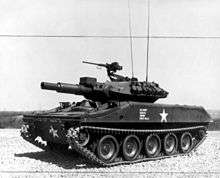
In the immediate post-World War II era, the U.S. Army introduced the M41 Walker Bulldog into service to fill the role of a light tank. The lifespan of the M41 was fairly short; at 25 tons it was considered too heavy to be a true light tank, and had a rather short cruising range. Plans were started to build an even lighter replacement mounting the same gun, resulting in the T71 and T92 test designs. Two prototypes of the 19 ton T92 were later ordered. However, as the prototypes were entering testing, information about the new Soviet PT-76 light tank became available. The PT-76 was amphibious, and soon there were demands that any U.S. light tank should be able to swim as well. The T92 was already in the prototype stage and could not be easily refitted for this role, so the design of an entirely new system started as the XM551.
In the 1960s the Army was also developing the MBT-70 main battle tank with West Germany. Fearing Congress would balk at funding two developmental tank programs, the Army chose to designate the Sheridan as an armored reconnaissance vehicle rather than a light tank.[6] At the time of the M551's acceptance into service production in 1966,[3] the United States Army no longer used the heavy, medium, and light tank classifications. In 1960, with the deactivation of its last (M103) heavy tank battalion, and the fielding of the new M60 series tank, the U.S. Army had adopted a main battle tank (MBT) doctrine; a single tank filling all combat roles.[7][8] The U.S. Army still retained the M41 Walker Bulldog light tank in the Army National Guard, but other than the units undergoing the transitional process, the regular army consisted of MBTs. Partly because of this policy, the new M551 could not be classified as a light tank, and was officially classified as an "Armored Reconnaissance/Airborne Assault Vehicle".
In April 1965 the Army awarded a four-year $114.5 million contract to the Cadillac Gage division of the General Motors Corporation (GMC) for the production of the M109 howitzer and the XM551 General Sheridan.[9] GMC said the Sheridan would begin production in January and be delivered to the Army in June.[10]
In February two squadrons totaling 54 Sheridans were operated in South Vietnam.[11] In March 1969, after the Army invoked secrecy in declining to disclose program costs, a Government Accountability Office (GAO) official said development costs had reached $1.3 billion. Congressman Samuel S. Stratton criticized Army officials for the program's high costs, and accused officials of concealing cost figures to cover up for their own "bumbling ineptness."[12] A GAO report leaked in May revealed the Army had fast-tracked the program to avoid budgetary scrutiny, despite indications by May 1966 that the tank's caseless ammunition was prone to cooking off. The problem had since then been resolved by a compressed-air system that forced hot ammunition residue from the breech, the Army told Congress. The Army said the Sheridan had performed well enough that it was planning to send hundreds more.[11] A Congressional report in July identified $1.2 billion wasted on the M60 and Sheridan. The report said attributed several Vietnam War casualties to Sheridan design faults, and said that the tank had been wholly unready for combat there "without extensive and costly retrofits."[13]
The vehicle designed to mount the gun had a steel turret and aluminum hull. Although the hull could deflect heavy machine gun fire of up to 12.7mm AP,[14] it was easily penetrated by rocket propelled grenades, which could destroy the vehicle if the spalling contacted the caseless main gun rounds. Like the M113 armored personnel carrier, it was also vulnerable to mines.
Swimming capability was provided by a flotation screen, similar to that used by the World War II, amphibious DD Tanks. The front armor was overlain by a wooden "surfboard", actually three folded layers, hinged together. This could be opened up into a sloping vertical surface in front of the driver providing a bow of a boat hull, about level with the top of the turret. Fabric formed the rest of the water barrier, folding up from compartments lining the upper corner where the side met the top of the hull, and held up at the back with poles. The front of the "hull" was provided with a plastic window, but in practice it was found that water splashing onto it made it almost useless, and the driver instead usually had to take steering directions from the vehicle commander. The M2 Bradley adopted a similar solution, but dropped it with upgraded armor.
In the Vietnam War, firing the gun often adversely affected the delicate electronics, which were at the early stages of the transition to solid state devices, so the missile and its guidance system was omitted from vehicles deployed to South Vietnam. The expensive missile was fired in anger only in the Persian Gulf War's Operation Desert Storm, despite a production run of 88,000 units.
Production
Production started on 29 July 1966, and it entered service in June 1967 with 1st Battalion, 63rd Armor Regiment at Fort Riley. In the end, 1,662 M551s were built between 1966 and 2 November 1970. Total cost of the M551 program was $1.3 billion. The M81 gun had problems with cracks developing near the breech after repeated firing, a problem that was later tracked to the "key" on the missiles that ran in a slot cut into the barrel. Most field units were modified to help address the problem, but later the modified M81E1 was introduced with a shallower slot, along with a matching modification to the missile, that cured the problem. The gun also has been criticized for having too much recoil for the vehicle weight, the second and even third road wheels coming clear off the ground when the main gun fired. Some were experimentally fitted with conventional 76mm guns, but these never entered service.
Service history
Vietnam War
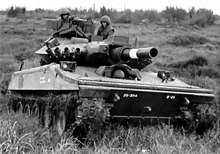
The U.S. Army staff in Washington had been recommending since 1966 to the commander of U.S. forces in South Vietnam, General Westmoreland, that the Sheridan should be used in Vietnam. However, since the main gun ammunition was not available, he argued that it was simply a $300,000 machine gun platform.[15] By 1968, the new, or soon to be, U.S. commander in South Vietnam, General Creighton Abrams, had been notified that the 152mm shells were now available for the Sheridan. However, as General Abrams began to make preparations for the equipping of U.S. cavalry squadrons for the vehicle, the affected squadrons expressed their concerns that the new aluminum tanks were not only highly vulnerable to mines and anti-tank rocket fire, but they would not be as capable of "jungle busting" as the M48A3 medium tanks.[15]
In late 1968, General Abrams met with Colonel George S. Patton IV - the son of World War II General Patton - who was the regimental commander of the 11th Armored Cavalry Regiment (11th ACR), the only full regiment of cavalry in South Vietnam. When General Abrams mentioned the cavalry's concerns over the new vehicle, Patton recommended that the Sheridans be combat tested by a divisional cavalry squadron as well as a squadron from his own regiment; as the squadrons had completely different missions.[15]
First deployment
The first Sheridans to arrive in South Vietnam did so in January 1969 and were accompanied by their factory representatives, instructors, and evaluators as the new vehicles were issued to the 3rd Squadron, 4th Cavalry Regiment,[16] and the 1st Squadron of the 11th ACR.[15] By the end of 1970, there were more than 200 Sheridans in South Vietnam,[17] and they stayed in the field until the last U.S. armored cavalry unit, the 1st Squadron, 1st Cavalry Regiment prepared for re-deployment back to the United States on 10 April 1972.[18] By the end of its combat debut in 1972, the Sheridan had seen extensive action in the Vietnam War, being assigned to nearly all armored cavalry squadrons involved in that conflict. In 1969, armored cavalry units (minus the 11th ACR, which retained its M48 tank companies) began replacing their M48 Patton tanks, which in turn were normally transferred to the South Vietnamese military. Like the M50 Ontos anti-tank vehicle, the battle reports from the troops were sometimes glowing, while the reports higher up the chain of command were often negative. This was largely due to the high casualty rate of both Sheridans and their crews as mines and rocket-propelled grenades (RPGs) that would only damage an M48 Patton tank, would destroy the Sheridan and kill or wound most, if not all, of its crew.[19]
A 1969 evaluation of the vehicles found that the M551 was employed in reconnaissance, night patrol and road clearing, accumulating 39,455 road miles and 520 combat missions, with a ready rate of 81.3 percent. Despite vulnerability to rockets and mines, it was judged worthy of applying modifications and equipping all cavalry squadrons with the Sheridan.[20]
First combat/first losses
In addition to the problems presented by aluminum construction, the Sheridan had a defect that no other common armored vehicle possessed: it fired caseless 152mm main gun rounds. These rounds were "fixed", meaning that, unlike the artillery, the warhead was factory attached to the propellant, and if the warhead separated from the propellant during loading, which was not uncommon, the crewmen were instructed not to load the round. Sometimes, these unspent propellant charges remained on the turret floor due to the emergencies at the time, and in either case, all of the remaining serviceable 152mm shells still remained caseless, albeit attached to their warheads, and sleeved into a re-usable white nine-ply nylon[21] bag, which was form-fitted to hold the propellant portion of the shell. The white/silver-colored bag had a strap attached to the bottom, which the loader would grab and pull off prior to gently inserting the shell into the breech. Once a mine or RPG-type weapon created the spark, smoke and fire became imminent, and it became a matter of Standing Operating Procedure to abandon the tank immediately.[22] On 15 February 1969, just one month after the Sheridan's arrival in South Vietnam, an M551 from the 3/4th Cavalry detonated a 25-pound pressure-triggered land mine, which ruptured its hull and ignited the 152mm shells, resulting in a secondary explosion that destroyed the tank.[15] In late 1969, nine Sheridans from the 4th Squadron, 12th Cavalry Regiment were fording a river near the DMZ, when three of the M551s detonated mines, completely destroying them. On March 1971, five Sheridans from the 11th ACR were lost in one day to RPG fire; all five vehicles burst into flames and were totally destroyed.[21] It became a common scene to observe melted Sheridan hulls with their sunken steel turrets sitting at odd angles with their gun tubes pointing towards the sky in various parts of the country, either awaiting final disposition, or simply forgotten.[23]
Performance
The Sheridan had several advantages: it did not get stuck in the mud as often as the 52-ton M48 Patton tank did, nor did it throw its track off as often.[24] This alone was enough to win the tank crews' favor. The light weight and high mobility proved their worth, and the gun proved an effective anti-personnel weapon when used with either the M657 HE shell or the M625 canister round, which used thousands of flechettes as projectiles.
The reliability of the engine system and gun of the tank was, however, not fully up to the task. Of 74 M551 sent to Vietnam in February 1969, by May there were recorded 16 serious mechanical faults, 41 failed shots, 140 defective ammunitions and 25 burned engines; the turret itself had 125 electric faults, several recoil system faults and instances of blown up guns. As an additional problem, much of the carried machine-gun ammunition had to be stored outside the turret as the internal space was extremely limited.[25]
Although an average M48 Patton crew could fire as many as seventeen 90mm shells during a "mad minute" (60 seconds with all guns firing-on command), the Sheridan was known to put out only two 152mm shells during the same time frame. While the M48's 90mm cannon fired fixed metallic cased rounds, the 152mm was caseless. The caseless rounds needed air vents to clear the gun tube and breech prior to loading another round, while the M48 breech block opened as the used shell was ejected and closed as the new shell was shoved in. The faster the loader, the faster the Patton's gun could be fired. For the Sheridan, the loader had to wait for the mechanism. After firing, the loader would have to wait, as the breech slowly opened rearward then turned downward. After another instrument indicated that all turret systems were still operational, the loader would gently push the 152mm fixed round into the breech and watch the breech block slowly rotate upward, then forward into the breech, then again, wait for the lights.[26]
The Sheridan was much appreciated by the infantry, who were desperate for direct-fire support, and generally served in armored cavalry units along with ACAVs (M113s). Armor units consisted solely of tanks (minus headquarters company) and mechanized infantry units consisted solely of M113s. In this role, the real problem with the Sheridan was its limited ammunition load; normally, only 20 rounds and 8 missiles; although, as the M551s in Vietnam service were not equipped with missiles or their guidance equipment, this increased the basic load of conventional rounds. Sheridan losses were heavy during normal operations, largely due to land mines and anti-armor weapons, but were especially heavy after the start of the Cambodian Campaign on 1 May 1970 in which, among other cavalry squadrons, the 11th ACR was thrown into the fight. The second heaviest losses were during the U.S. Army's final offensive of the war, operation Dewey Canyon II, when the Cavalry's remaining Sheridan squadrons met near disaster on the Laos border during the early months of 1971, in particular the 1/1st Cavalry.[23]
Combat field modifications
A common field-modification was to mount a large steel shield, known as an "ACAV set" (Armored Cavalry Assault Vehicle), around the commander's 50-cal. (12.7 mm) gun, allowing it to be fired with some level of protection. The driver has an unusual rotating hatch which has vision blocks when rotated forward. Included with the set was an extra layer of steel belly armor which was bolted onto the vehicle's bottom, although only covering from the front to half way to the end, possibly due to weight reasons.
A standard modification made during the mid-70s was the addition of the "Cereal Bowl" commander's cupola. This mod came about due to the "broken rib" effect that occurred when the Sheridan fired conventional rounds; the recoil would pitch the commander against the armor plating, resulting in cracked ribs.
Post-Vietnam War service
The Army began to phase out the Sheridan in 1978, although at the time there was no real replacement. Nevertheless, the 82d Airborne Division was able to keep them until 1996. The Sheridan was the only "rapidly" air-deployable tank in the inventory. Their units were later upgraded to the M551A1 TTS model, including a thermal sighting system for the commander and gunner.
In the early 1980s, the M551A1 was fitted with a visual modification kit to resemble Warsaw Pact vehicles from Soviet BMP-1, ZSU-23, T-55 to T-80s, at the National Training Center at Fort Irwin, California. These modified vehicles were used in part of the U.S. Army's Soviet opposition forces (OPFOR) by providing realistic ground training to U.S. military units about Soviet combat doctrine in a desert environment.[5] The OPFOR Sheridans no longer fulfill that role, having been retired at the end of 2003 and subsequently scrapped or made available as "hard targets" or, in a few cases, as museum pieces. Many were dumped to create artificial reefs.
During Operations Desert Shield and Desert Storm, 51 Sheridans were deployed by the 82nd Airborne Division, and were among the first tanks to be sent. Although photos that were published at the time showed rows of Sheridans ready to defend against Iraqi tanks, they would have a limited effect against the Soviet-designed T-72s which comprised the bulk of the Iraqi Republican Guard. Their role was limited to reconnaissance due to their age and light armor. It is likely that no more than six Shillelagh missiles were fired[27] at Iraqi anti-tank guns or T-55s; this was the only occasion in which Shillelagh missiles were fired in a combat environment, from the inventory of 88,000 missiles produced.
The Sheridan's only air drop in combat occurred during the United States invasion of Panama (Operation Just Cause) in 1989, when fourteen M551s were deployed: four were transported by C-5 Galaxy and ten were dropped by air, though two Sheridans were destroyed on landing.[28] The four M551s transported by the C-5 were secretly deployed to Panama[29] in November 1989, where they were attached to TF Bayonet (193rd Infantry Brigade), and attached down further to TF Gator. These Sheridans took part in the attack on the Comandancia, initially supported by fire from Quarry Heights, and later displacing forward into the city. As part of Team Armor, these Sheridans later provided support to JSOC elements as they secured high-value targets throughout Panama City. The remaining eight Sheridans were delivered to Torrijos-Tocumen Airport some hours after H-hour by Low-Velocity Airdrop (LVAD) technique from C-130 transports. The Sheridans' performance received mixed reviews. They were lauded by their operators and some commanders as providing firepower in needed situations to destroy hard targets. However, the Sheridans' use just of HEAT rounds limited their effectiveness against reinforced concrete construction.
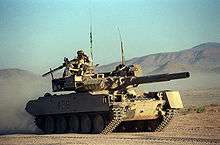
Several attempts to improve or replace the Sheridan have been made over the years since it was introduced. Several experimental versions of the Sheridan mounting a new turret carrying the NATO-standard 105mm gun were made, but the resulting recoil was so great as to make the vehicle almost unusable. The Army sought replacement in the United Defense M8 Armored Gun System, but the program was canceled in 1997 by the Pentagon before it could enter production.[30] United Defense again pitted their AGS against other vehicles in the Mobile Gun System program of the 2000s. The AGS lost out against the wheeled General Dynamics Land Systems Stryker M1128 Mobile Gun System.
Australian trials
During 1967 and 1968 the Australian Army trialled two Sheridans to determine if the type met a requirement for light armored fighting vehicles to serve with the Royal Australian Armoured Corps newly formed cavalry regiments. The main trials took place in the tropical Innisfail area of north Queensland between January and June 1968. In January 1969 the Minister for the Army announced that Australia would not purchase any Sheridans as the tanks did not meet the Army's requirements. The main shortcoming revealed in the trials concerned the safety of the combustible case. The two Sheridans were returned to the U.S. Army in early 1969, and the Australian Army met its requirement by fitting turrets from Alvis Saladin armoured cars to M113 armored personnel carriers.[31]
Design
Armament
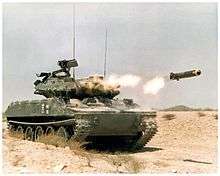
Building a vehicle lighter than the T-92 required an innovative solution for the main armament. A gun firing kinetic energy penetrators to defeat modern tanks at reasonable range was too large for the XM551; gun weight was typically dependent on caliber and muzzle velocity. This was solved by arming the XM551 with a 152mm M81 gun firing low velocity M409 HEAT rounds. The large caliber ensured it would produce a powerful shaped charge effect capable of penetrating tank armor, since velocity has no effect on shaped charge penetration, while the short gun would reduce overall weight.
The gun was ideal for infantry support. The large, low velocity gun could fire a large explosive shell or canister shot. In comparison, high-velocity anti-tank guns over-penetrated soft targets, while smaller caliber weapons could not carry as great a payload.
The M81E1 was not ideal in medium- and long-range tank engagements as its low velocity produced extended flight times, and made it difficult to lead moving targets. Therefore, the gun was also designed to fire MGM-51 Shillelagh anti-tank missiles.[32] The low launch velocity against longer-ranged targets was not an issue for the missile. However, the MGM-51 was considered a risky project.
A number of existing vehicles already mounted only ATGMs, or alternately recoilless rifles like the M50 Ontos, but these typically had limited utility in the infantry support role, or in the case of Ontos could not be reloaded from within the vehicle. The XM551 appeared to offer a superior balance between anti-tank and infantry support.
Mobility
Tactical mobility
The Sheridan was powered by a large 300-hp (224 kW) Detroit Diesel 6V53T diesel engine. The XM551 thus had an excellent power-to-weight ratio and mobility, able to run at speeds up to 45 mph. However, the vehicle proved to be very noisy and unreliable under combat conditions.
The Sheridan could swim across a river that was about 50 yards wide. Tanks in the Patton series (M46, M47, M48), as well as the M60 main battle tank[33] could not perform these operations; they would have to crawl along the river bottoms using snorkels. Not by design, it was found that the swimming hardware acted to reduce the effectiveness of RPG hits, but it was rarely used in Vietnam.
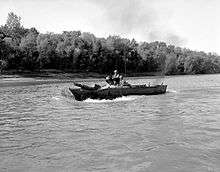
Strategic mobility
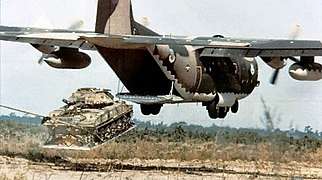
The Sheridan can be rigged for low-velocity airdrop from C-130 (19,000 kg, 42,000 lb max load), C-141 aircraft (17,460 kg, 38,500 lb max load),[34] and the C-5.[35] Many films exist showing the Sheridan being pulled out of a C-130 Hercules transport by brake chutes and skidding to a stop. The Low Altitude Parachute Extraction System (LAPES) is a somewhat risky maneuver that allows accurate delivery onto a field when landing is not possible, and the practice was stopped in the late 1990s. The tank is strapped down to a special pallet which absorbs most of the landing impact. The crew does not ride in the tank during extraction, but parachutes from another plane. On landing, they go to their tank, release the lines, and drive it away.
Variants
- XM551/M551 - The M551 was the basic production model, beginning production in 1967. The XM551 had been a limited run pre-production model produced in 1965.
- "Two Box" M551 - With the obvious shortcomings of the Shillelagh missile, all but two of the guidance and fire control components of the missile system were removed (the power supply and rate sensor were retained. These were needed for stabilized turret operation.). The resulting additional space was filled with two separate boxes, one for 7.62×51mm NATO ammunition (coaxial machine gun), and one for 12.7×99mm NATO (.50 BMG) ammunition, and the missile stowage was redesigned to accept conventional rounds.
- M551A1 - Upgraded M551 with AN/VVG-1 laser rangefinder.
- M551A1 TTS - Tank Thermal Sight, fitted with the AN/VSG-2B thermal sight unit, similar to the unit used on the M60A3 MBT. This later became standard to all M551A1s.
- M551 NTC - National Training Center. Using M551 hulls, the NTC created a number of mock vehicles for training exercises resembling common Soviet/Warsaw pact types. They were also known as 'vismods', short for VISually MODified. They have since been retired in favor of similarly converted M113s and M1 Abrams.
Display vehicles
- Camp Joseph T. Robinson, Arkansas National Guard Museum[36]
- Carolinas Aviation Museum
- Fort Benning, static display on Tower Branch of U.S. Army Airborne School across from Maneuver Center of Excellence.
- First Division Museum at Cantigny,[37] an example of the M551A1 is on display in the tank park outside the First Division Museum at Cantigny in Wheaton, Illinois
- Antioch, Illinois has a veterans monument displaying a M551A1 across the street from the police station.
- Fort Irwin/NTC, has one vehicle on display at the 11th Cavalry Regiment museum.
- Fort Polk, a "T-72" VISMOD is on display on Mississippi Avenue near the headquarters of 1st Battalion, 509th Parachute Infantry Regiment.
- Fort Richardson, Camp Denali on static display
- Gowen Field, Idaho Army National Guard
- Hardwood Range,[38] an example is on static display at the visitor center at Hardwood Air-to-Ground Weapons Range in Finley, Wisconsin.
- The Ontario Regiment Museum, in Oshawa, has two Sheridan tanks on display. One is in not operating condition and the other has been restored with its original 11th Cavalry markings.
- Camp Perry, near Port Clinton, Ohio, has an M551 on display as part of a static display.
- Airborne & Special Operations Museum, Fayetetteville, NC[39]
- The American Armoured Foundation's Tank and Ordnance War Memorial Museum, Danville, VA. M551A1 deployed in Desert Shield/Storm. Markings: 3rd Battalion 73 Regiment, Co. B, 2nd platoon, attached to the 82nd Airborne Division.
- Fort Hunter Liggett on static display at the entrance.
- The American Heritage Museum, Stow, Massachusetts has an M551 that is in operating condition.
- American Society of Military History and Museums, South El Monte, Ca. 2 non running exhibits and a running, ex-vismod unit.[40]
- Fort Knox, Kentucky. Static display at Wilson Road entrance
- Ike Skelton Missouri National Guard Training Facility, Jefferson City Missouri Ike Skelton Training Facility has a M551 in their outside museum
- Fort Bliss, static display at Sheridan Gate entrance.
- Camp Beauregard in Pineville, LA static display outside of the post museum.
- Museum of Missouri Military History, on static display outside the museum
- Watervliet Arsenal
- Yuma Proving Ground in Yuma, AZ. On static display outside range control.
- Mott's Military Museum in Groveport, Ohio has an M551 on display outside with other various vehicles.
- Vietnam Veterans of America, in Baltimore, MD has an M551A1 on display outside of the building at 6401 Beckley St.
See also
- List of "M" series military vehicles
- List of vehicles of the U.S. Armed Forces
- M60A2 used a similar 152mm gun which also fired the Shillelagh missiles.
- M3 Bradley a modern AFV that sometimes covers the same roles.
References
- Notes
- Tom Clancy (1994). Armored cav: a guided tour of an armored cavalry regiment. Penguin. ISBN 978-1-101-00226-1. Retrieved 20 January 2011.
- Defense Industry Bulletin (May 1965), p. 25
- Hunnicutt, R. P. "Sheridan: A History of the American Light Tank." Volume 2, 1995, Presidio Press; ISBN 0-89141-570-X.
- Nikola Budanovic. "War History Online: Tank Profile: M551 Sheridan". Retrieved 15 January 2017.
- Byron Hartshorn. "The Strange Second Life of the M551 Sheridan Light Tank". Retrieved 16 February 2015.
- Middleton, Drew (20 June 1962). "NATO Ponders How to Overcome East Bloc's Tank Superiority". The New York Times. Retrieved 13 August 2018.
- Hunnicutt, R. P. "Firepower: A History of the American Heavy tank." 1988, Presidio Press; ISBN 0-89141-304-9.
- Hunnicutt, R. P. "Patton: A History of the American Main Battle tank." 1984, Presidio Press; ISBN 0-89141-230-1.
- "Contract Awards". The New York Times. Associated Press. 13 April 1965. Retrieved 15 August 2018.
- "Chevy Rounds Out Its Biggest Year". The New York Times. 29 December 1965. Retrieved 15 August 2018.
- Sheehan, Neil (15 May 1969). "Army Accused of Rushing Work On Tanks to Avoid Budget Scrutiny". The New York Times. Retrieved 14 August 2018.
- "Army Is accused of Hiding 'Ineptness' in Tank Program". The New York Times. UPI. 14 March 1969. Retrieved 14 August 2018.
- "U.S. Tank Systems Attacked In House". The New York Times. 10 July 1969. Retrieved 14 August 2018.
- Bryan, Steven J Zaloga ; illustrated by Tony (2009). M551 Sheridan : US airmobile tanks, 1941-2001. Oxford: Osprey. ISBN 978-1-84603-391-9.
- Starry p. 143
- "Archived copy". Archived from the original on May 7, 2013. Retrieved July 30, 2013.CS1 maint: archived copy as title (link) CS1 maint: BOT: original-url status unknown (link)
- Starry p. 144
- Starry
- Starry pp. 143–145
- Washer evaluation 1969 Archived 2011-07-14 at the Wayback Machine
- Dunstan, Simon. Vietnam Tracks-Armor In Battle. 1982 edition; Osprey Publishing Limited. ISBN 0-89141-171-2.
- Starry (1989), p.144-145.
- Nolan (1986), p.
- ARMY CONCEPT TEAM IN VIETNAM APO SAN FRANCISCO 96384. Optimum Mix of Armored Vehicles for Use in Stability operations Volume 1. 31 MAR 1971
- Pignato, Nicola, 'History of armour veichles', 1976, F.lli Fabbri editions, Bologna, p.630
- Stanton (2003), p.277.
- Doyle, p. 4
- Doyle, p. 44, 46
- Doyle, p. 55
- Arenstein, Seth (4 March 1996). "AGS killed as Army budget rises". Defense Daily. Archived from the original on 13 April 2017. Retrieved 12 April 2017.
- "Paul D Handel, Sheridan Tropical Trials in Australia". Anzacsteel.hobbyvista.com. Retrieved 2014-04-10.
- "Sheridan Tank Weapons Demonstration (1969)". Special Operations History Foundation. Retrieved 30 April 2013.
- Hunnicutt, History of MBT, p. 149, 150, 174
- "Gary's Combat Vehicle Reference Guide". Inetres.com. Retrieved 2014-04-10.
- "4 x M551 Sheridan Light Tanks LVAD C-5B Paradrop". YouTube. 2007-11-24. Retrieved 2014-04-10.
- "arngmuseum.com". arngmuseum.com. Retrieved 2014-04-10.
- "First Division Museum at Cantigny". Firstdivisionmuseum.org. Archived from the original on 2012-07-03. Retrieved 2012-10-25.
- "Wisconsin Air National Guard: Hardwood Air-toGround Weapons Range, Finley, Wisconsin" (PDF). Volkfield.ang.af.mil. Retrieved 2012-10-25.
- "Airborne & Special Operations Museum - Fayetteville, NC". Asomf.org. 1940-08-16. Archived from the original on 2014-03-05. Retrieved 2014-04-10.
- GNP (2011-10-19). "tankland.com". tankland.com. Retrieved 2014-04-10.
- Bibliography
- Doyle, David. M551 Sheridan. (2008) Squadron Signal Publications. ISBN 978-0-89747-582-2.
- Nolan, Keith W. Into Laos, Operation Lam Son 719 and Dewey Canyon II. Presidio Press: 1986.
- Sorley, Lewis. Thunderbolt: General Creighton Abrams and the Army of His Time. 1992. ISBN 0-671-70115-0.
- Stanton, Shelby, L. Vietnam Order of Battle. (1983–2003) ISBN 0883657090.
- Starry, Donn, GEN. "Mounted Combat In Vietnam." Department of the Army publication, 1989.
- Zaloga, Steven J., M551 Sheridan, US Airmobile Tanks 1941–2001. Osprey Publishing Ltd, 2009.
External links
| Wikimedia Commons has media related to M551 Sheridan. |